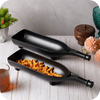

You ever think about how much your pots and pans affect your cooking? I mean, every meal you whip up touches those surfaces, so it’s kind of a big deal to pick ones that are good for you. I learned this the hard way after years of using whatever was cheapest, only to realize some cookware can sneak unwanted stuff into your food. Yikes! So, let’s talk about the healthiest, safest cookware out there—stuff that’s kind to your body and makes your meals taste amazing. Whether you’re starting fresh or eyeing an upgrade, I’ve got you covered with tips to pick the best pots and pans.
Why Your Cookware Matters
Okay, picture this: you’re cooking dinner, and your pan’s coating is flaking into your stir-fry. Gross, right? The material your cookware is made of can affect your food—and your health—in sneaky ways. When pans heat up, some can leach tiny bits of metals or chemicals into your meal. Over time, that adds up. Here’s why you should care:
Some materials break down and mix with your food. Not cool.
Scratched-up or old pans are more likely to release weird stuff.
Uneven heating can mess up your cooking, leaving you with burnt or underdone food.
Certain pans need extra love to stay safe and last forever.
I used to grab whatever was on sale, but after a scratched non-stick pan ruined my vibe, I started paying attention to what my cookware was made of. Let’s break down the best options so you can cook with confidence.
The Lowdown on Cookware Materials
Here’s the scoop on the most popular cookware materials, what makes them awesome, and what to watch out for.
1. Stainless Steel
Stainless steel is like the trusty friend of the kitchen—always there, super reliable. I got my first set years ago, and it’s still going strong.
Why It’s Awesome :
It’s non-reactive, so it won’t mess with the flavor of your food (no metallic-tasting spaghetti sauce here).
High-quality stainless steel (look for 18/10 grade) is crazy durable and safe.
Cleans up easy and laughs in the face of the dishwasher.
Things to Know :Cheaper stainless steel might leach a tiny bit of nickel or chromium with acidic foods like tomatoes. Stick to good-quality stuff.
It’s not non-stick, so you’ll need a splash of oil or butter to keep things sliding.
Bottom Line : Stainless steel is a solid, healthy pick for everyday cooking. It’s my go-to for everything from soups to stir-fries.


2. Cast Iron
Cast iron is like the wise old grandma of cookware—tough, timeless, and full of character. My cast iron skillet is my kitchen BFF.
Why It’s Awesome :
It adds a bit of iron to your food, which is great if you’re low on this nutrient (hello, extra health points!).
Super durable—my skillet was my mom’s, and it’s still a champ.
Perfect for searing steaks, frying eggs, or even baking cornbread.
Things to Watch :Acidic foods like tomato sauce can wear down the seasoning if you cook them a lot.
You’ve got to season it and dry it well to avoid rust. It’s a bit of work, but worth it.
It’s heavy! My arms get a workout just lifting it.
Bottom Line : Cast iron is a healthy, natural choice if you’re cool with giving it some TLC.


3. Ceramic Cookware
Ceramic cookware is the new kid on the block, and I love how it’s non-stick without the sketchy chemicals.
Why It’s Awesome :
Made from natural stuff, free of nasty chemicals like PFOA or PTFE.
Super easy to clean—sometimes I barely need soap.
Heats up evenly, so no random hot spots burning your food.
Things to Know :The coating can wear out faster than other materials, so you might need to replace it every few years.
Don’t shock it with sudden temperature changes—it might crack.
Bottom Line : Ceramic is a safe, eco-friendly pick, especially for low to medium heat cooking like eggs or veggies.


4. Glass Cookware
Glass cookware is like the pure, no-drama option. I use my glass baking dish all the time for casseroles.
Why It’s Awesome :
Totally non-reactive, so it won’t add anything weird to your food.
Easy to clean, doesn’t stain, and never holds onto smells.
Things to Watch :It’s not for stovetop cooking—just ovens or microwaves.
It can shatter if you drop it or go from hot to cold too fast. Handle with care!
Bottom Line : Glass is a safe bet for baking and slow cooking, but it’s not an all-purpose player.
5. Non-Stick Cookware (Teflon and Alternatives)
Non-stick pans are like the easy button of cooking, but they come with some baggage. I used to love mine until I learned a few things.
Why People Love Them :
Food slides right off—perfect for eggs or pancakes.
You can use less oil, which is great if you’re watching calories.
Things to Be Careful About :Old-school Teflon can release toxic fumes if it gets too hot (like above 500°F). Scary stuff!
Newer ceramic-based non-stick pans are safer but wear out quicker.
Skip metal utensils—they’ll scratch the surface and ruin it.
Bottom Line : Use non-stick carefully, don’t crank the heat, and replace it when it starts looking rough.
6. Copper Cookware
Copper pans are like the fancy chef’s choice—I drool over them in cooking shows.
Why It’s Awesome :
Heats up fast and evenly, giving you pro-level control over your cooking.
Things to Know :Copper can leach into food, which isn’t great in big amounts. Most copper pans are lined with stainless steel or tin to keep things safe.
They need regular polishing to stay shiny. It’s high-maintenance but gorgeous.
Bottom Line : Copper’s safe if it’s lined and you’re okay with a bit of upkeep.
How to Pick the Best Cookware for You
Here’s a quick cheat sheet to help you choose cookware that’s healthy and fits your life:
Cookware |
Health Safety |
Durability |
Maintenance |
Best For |
Stainless Steel |
Awesome |
Super high |
Easy |
Everyday cooking, searing |
Cast Iron |
Really good |
Forever |
Medium |
Frying, baking, long-term love |
Ceramic |
Awesome |
Decent |
Medium |
Gentle cooking, easy cleanup |
Glass |
Awesome |
Fragile |
Easy |
Baking, slow cooking |
Non-Stick (Ceramic-based) |
Good |
Decent |
Medium |
Low-fat cooking, quick meals |
Copper (lined) |
Good |
Decent |
High |
Precise cooking, fancy vibes |
Tips to Keep Your Cookware Safe and Happy
Don’t crank the heat too high—it can damage coatings or make pans release weird stuff.
Use wooden, silicone, or plastic utensils to keep surfaces scratch-free. I keep a wooden spoon handy at all times.
Replace beat-up cookware. If it’s scratched or chipped, it’s not doing you any favors.
Follow the care instructions. A little love goes a long way to keep your pans in top shape.
Ditch damaged non-stick pans. Once the coating’s peeling, it’s time for a new one.
My Cookware Journey
I’ll be real—I used to be all about non-stick pans because they were so easy. Scrambled eggs? Done. Cleanup? A breeze. But then I read about how overheating them could release toxic stuff, and I got nervous. So, I started mixing it up with stainless steel and cast iron. My cast iron skillet is like a family member now—I season it, talk to it, and it makes the best crispy potatoes. Knowing my food is safe and my pans aren’t sneaking chemicals into my meals gives me such peace of mind. It’s been a game-changer.
Wrapping It Up
The best cookware for your health is the kind that keeps your food clean, fits how you cook, and feels right in your kitchen. Stainless steel, cast iron, and ceramic are my top picks for safety and performance. Glass is great for baking, and non-stick can work if you’re careful and don’t let it overheat.
No single pan does everything, so having a mix in your kitchen is the way to go. You’ll be ready for anything—whether it’s a quick weeknight stir-fry or a fancy Sunday roast. Got questions about picking the right cookware? Let me know what you’re cooking, and I’ll help you find the perfect fit!














